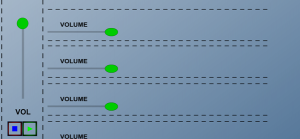by Sean McGrath (The University of Nottingham)
Recent endeavours at the Mixed Reality Lab at Nottingham have explored the use of mixing in consumer audio. As technology becomes more pervasive, consumers now have substantially more options in their choice of listening experiences. We aim to explore the role of volume in multi-track audio and to ascertain to what degree control over audio features can benefit users in their everyday listening experiences.
The research is driven by the following questions:
- Can non-optimal audio be mixed in an optimal way? How do users reason about this?
- Do these additional controls afford additional utility and if so, how might they improve the user experience?
- How does context define the level of control, access and utility in this scenario?
The work utilises a technology probe developed by Dr Sean McGrath at the MRL. The probe is a simple web-based application that pre-loads a series of multitrack components and randomises the order in which they are played. This enables the representation of both optimised and non-optimised mixes where repetition of tracks is possible. For instance, a listener may be presented with four distinctive instrument tracks, four identical drum tracks or some permutation between. The interface offers no way of knowing what mix is present, other than by adapting volume controls to try to ‘discover’ the configuration in place.

Figure 1 – Controls on the interface display current volume, master audio volume control and individual track audio controls.
The tool has been placed in a variety of different settings, at home and at work. Here we aim to mimic listening habits, relying on familiar hardware and environments, with the tool a centrepiece of this. The hybrid mix of a new tool embedded in existing setups presents context-driven problems and solutions. The focus is on adding utility and control and better understanding how we can build malleable music listening experiences for future audiences and contexts.
User feedback has placed the tool into a number of useful contexts, alluding to places where implantation of such controls would or could be beneficial. There has also been feedback about how the tool could be adapted for different contexts, such as in the car or in a shared space. The work has encompassed the social element of music listening, looking at how groups engage with the tool in socially rich settings and exploring the use of the tool in mitigating factors such as control, access and expression. The work is currently being written up as a paper.



